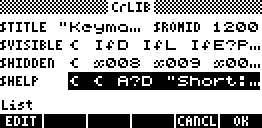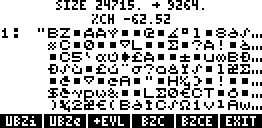Aims at making the life on the 49 more easy. Serves
both, the normal user and the expert. It offers library-,
menu-, programming- and compression-tools and allows to
recall menus, standard or user key assignments, and to toggle
fonts, flags and other items. If you learn using at least
some OT49 commands, your calculator will become much more powerful.
Some options should be assigned to keys, e.g. DType, 3tog,
S?UK and perhaps some togglers from page 2. Particularly
interesting is D![]() L
for creating and splitting libraries. It is the primary tool
for customizing the HP49 HELP engine for self-made libraries (since ROM 19-6). Hence, your
49
ROM should not be older than 19-6. The library for the 49 is OT49,
the one for the 49+ is OT49Plus (internally OT49+). Tested in ROM 19-6, 1.22
and 1.23.
L
for creating and splitting libraries. It is the primary tool
for customizing the HP49 HELP engine for self-made libraries (since ROM 19-6). Hence, your
49
ROM should not be older than 19-6. The library for the 49 is OT49,
the one for the 49+ is OT49Plus (internally OT49+). Tested in ROM 19-6, 1.22
and 1.23.
Store the library in a port. Any warmstart (ON_hold F3) attaches OT49(+) and the built-in libraries 256 and 257. For using the full calculator power, we recommend to load the library extable (e.g., from the Emacs package). The old Display-Off command Ð is not anymore supported by ROM 1.23. This is the main reason for different libs. Ð has been replaced by the command INFO in OT49+. Also header size toggling has been removed in OT49+ because this doesn't make sense on the 49+. A user of the 49 should update to version 1.2004 of OT49, a user of the 49+ to OT49+ to 4.2004.
What is NEW?
Version 4.2004 (only OT49+). S?UK displays nicely in the header also if the clock is on.
Version 3.2004 (only OT49+). Sys~ improved. Handles asm code now independently on flag -92.
Version 2.2004 (only OT49+). BZ-compression not interruptable anymore (compressor revised).
Version 1.2004 (only OT49+). ~HEAD and Ð replaced by ~MINI, INFO, resp. BZ compressor simplified.
Version 9.2003 (only OT49). Very hidden bug in DType fixed.
Version 8.2003. The flashpointer recaller in DType rewritten. Some other small improvements. OT49+ added for the HP49+.
Version 7.2003. XLIB 360 25 is a system flag toggler. Its former functionality is now a visible command in the library Hide.
Version 6.2003. html-document added, a revised version of OT49.txt. As in a web-site, putting the Cursor on a picture yields additional information. LMN slightly modified.
Version 5.2003. Toggler on page 2 and BZDIR improved.
Version 4.2003. Small bug in Flg~ fixed. Header update correct also if toggling flag -67.
Version 3.2003. In future one can hide files also with the filer (Filer1 or Filer2, version 3.2003). Therefore, the OT49 hiding tools are replaced by system parameter togglers. Who likes slighly more comfortable hiding tools may use the HIDE library 273. Purge moved to the last page. Hence, people who used this command in own programs must reprogram these.
Version 9.2002. BZ-toggler ~ decodes now compressed self-evaluating code, see below.
Version 8.2002. BZDir now compatible with the filers from the tool Filers. Existing compressed directories are not affected.
Version 7.2002.
D![]() L made still more user-friendly. DType
shows also the Dispatch Type of an object. S?UK now
displays both, Usr and Sys key numbering.
L made still more user-friendly. DType
shows also the Dispatch Type of an object. S?UK now
displays both, Usr and Sys key numbering.
Version 2.2002.
A new option $HELP is added to the dialog box in D![]() L
for creating a library. You may add HELPs for own library
commands shown when browsing CAT.
L
for creating a library. You may add HELPs for own library
commands shown when browsing CAT.
Version 1.2002.
BZDir replaces the former SFD since
ROM 19-6 introduced a new slightly more general command
DISPXY. Already in earlier versions the BZ-toggler has become a
powerful additional feature: Self-decompression and self-evalution
can be done inside a small code object. The following unnamed
rompointers are stable from now on, hence may trustfully be
used as long as OT49 is present on your calculator (you get e.g. the first
one on the stack with 360. 26. XLIB~, with XLIB~ from library 256):
XLIB 360 26 - a very small and fast BZ-decompressor. Warning: no argument checking!
XLIB 360 27 - argument protected BZstring fi (lter. Errors if the argument is
not a BZstring (string made with BZ-compressor).
Below, Alg, dir, lib, Lst, Prg, Str, zint, meta denote any algebraic object, directory, library, list, program, string, integer, or metaobject, resp. A metaobject is a collection of arbitrary stack-objects with a count in level 1 (a zint or real at the user level). All explanations below refer to RPN-mode only.
 Run D
Run D
